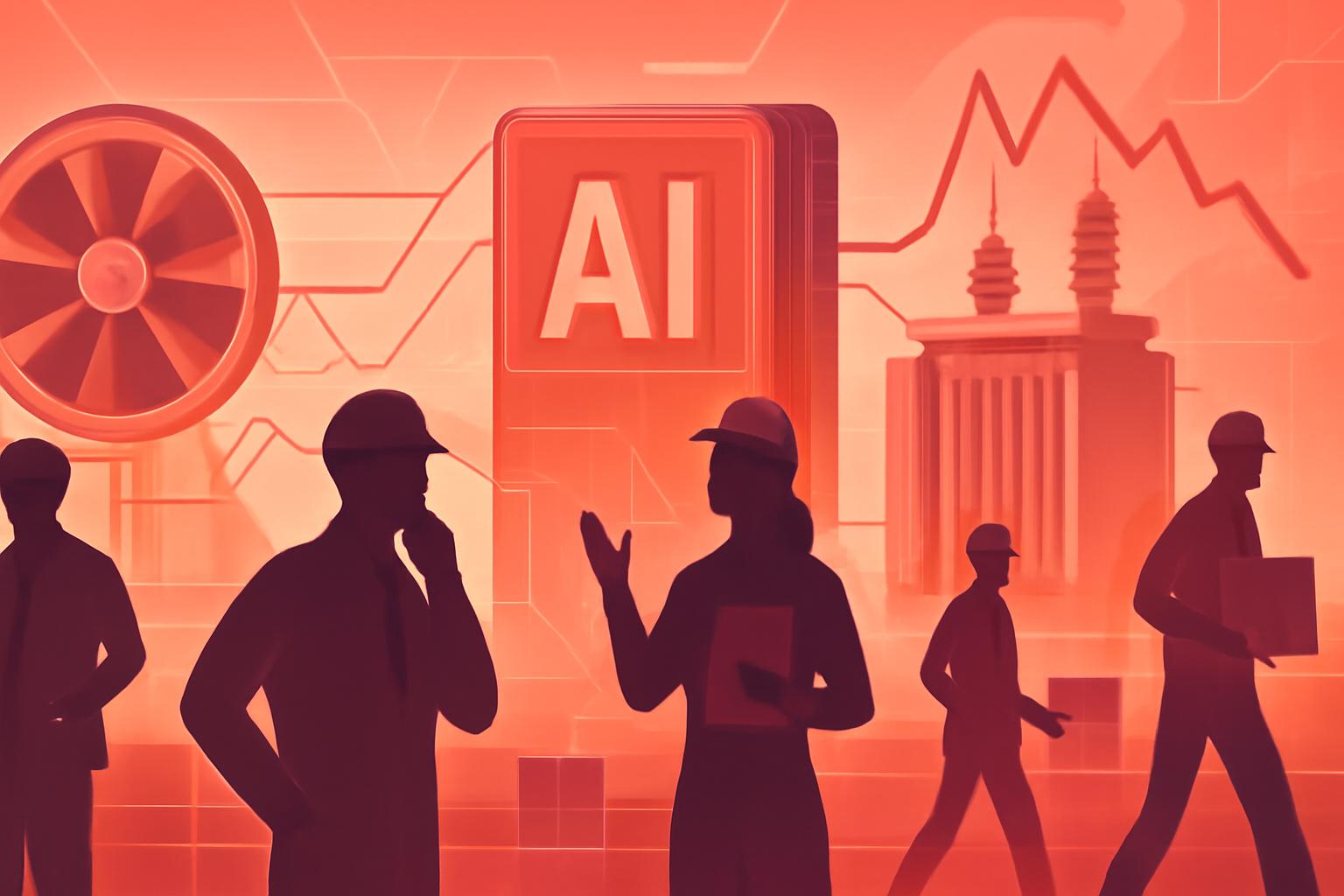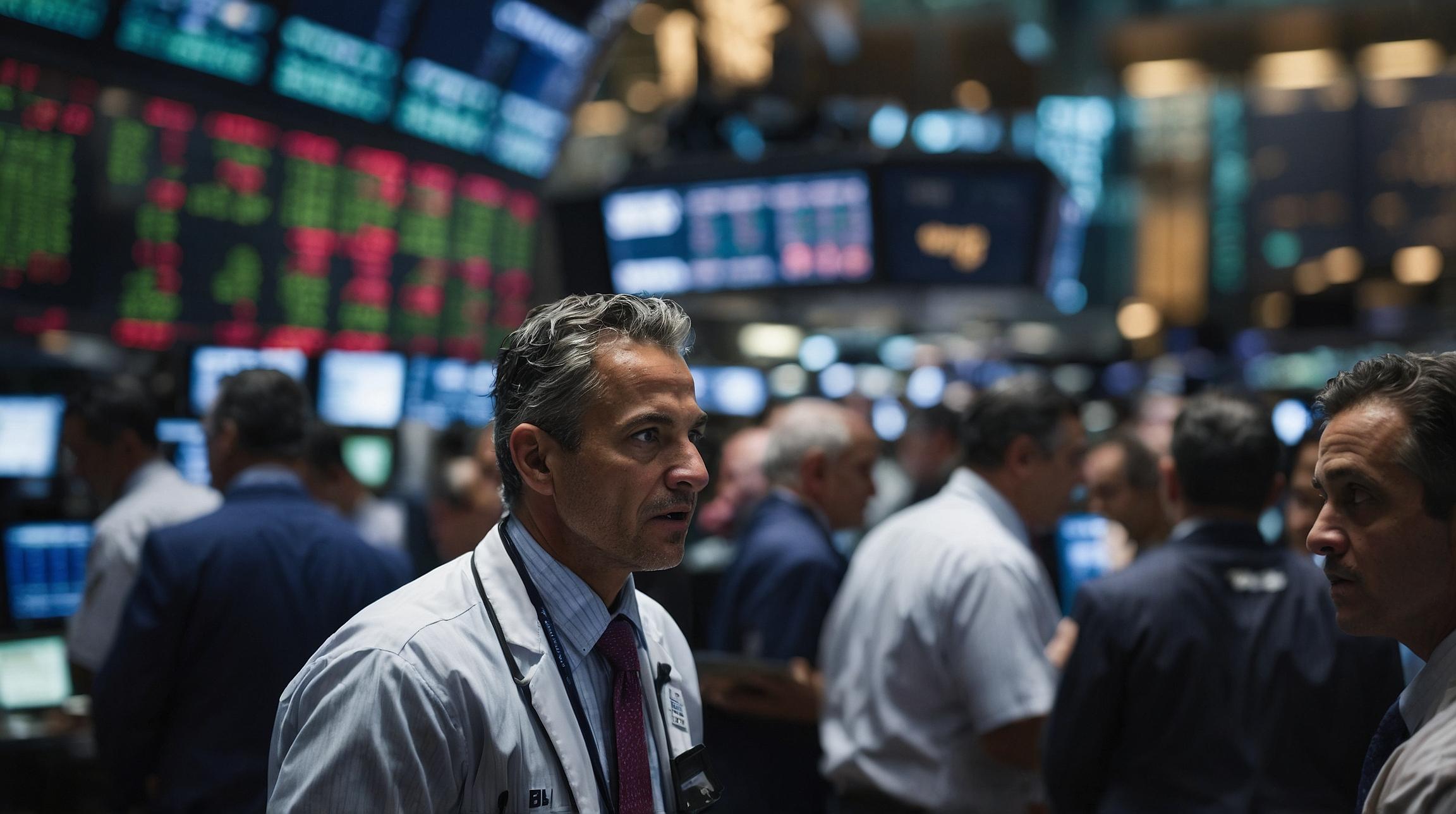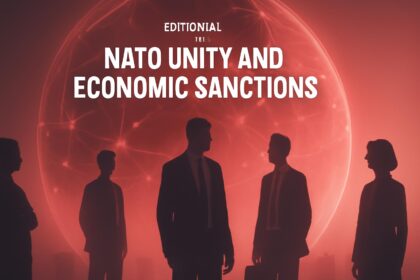Beyond hardware, the US faces a significant shortage of skilled labor necessary to complete these projects. The decline in trades such as welding, machining, and electrical work presents a “wartime-like” challenge to scaling the industrial workforce rapidly enough to meet project demands. !-- wp:paragraph -->
“We simply don’t have the skilled workforce in place to scale this fast. U.S. building trades are already in decline, with a shortage of welders, machinists and electricians. This could be just as big a pinch point as the hardware itself.” – Brandon Daniels, CEO, ExigerFinOracleAI — Market View
OpenAI and Nvidia’s $100 billion AI infrastructure initiative highlights critical vulnerabilities in the US supply chain and workforce capacity. The reliance on foreign suppliers for key components such as turbines, nuclear forgings, transformers, and steel, combined with tariff-induced cost pressures, poses significant risks to project timelines and budgets. !-- wp:paragraph -->- Opportunities: Potential expansion of domestic manufacturing capacity and skilled labor training programs to reduce import dependency.
- Risks: Continued supply chain bottlenecks, tariff escalations, and skilled labor shortages could delay AI infrastructure deployment and increase costs substantially.
- Strategic considerations: Policymakers and industry leaders must address trade policies and workforce development to support the scale required.
Impact: The AI infrastructure build-out presents a complex engineering and supply chain challenge that will test US manufacturing resilience and workforce readiness over the next five years.
Tariffs on imported materials such as steel and aluminum compound the cost challenges. Daniels notes that while some allied countries benefit from tariff exemptions, overall project costs could increase by 3% to 6%, translating into hundreds of millions of dollars for these multi-billion-dollar energy projects. !-- wp:paragraph -->Skilled Labor Shortages: A Critical Bottleneck
Beyond hardware, the US faces a significant shortage of skilled labor necessary to complete these projects. The decline in trades such as welding, machining, and electrical work presents a “wartime-like” challenge to scaling the industrial workforce rapidly enough to meet project demands. !-- wp:paragraph -->“We simply don’t have the skilled workforce in place to scale this fast. U.S. building trades are already in decline, with a shortage of welders, machinists and electricians. This could be just as big a pinch point as the hardware itself.” – Brandon Daniels, CEO, ExigerFinOracleAI — Market View
OpenAI and Nvidia’s $100 billion AI infrastructure initiative highlights critical vulnerabilities in the US supply chain and workforce capacity. The reliance on foreign suppliers for key components such as turbines, nuclear forgings, transformers, and steel, combined with tariff-induced cost pressures, poses significant risks to project timelines and budgets. !-- wp:paragraph -->- Opportunities: Potential expansion of domestic manufacturing capacity and skilled labor training programs to reduce import dependency.
- Risks: Continued supply chain bottlenecks, tariff escalations, and skilled labor shortages could delay AI infrastructure deployment and increase costs substantially.
- Strategic considerations: Policymakers and industry leaders must address trade policies and workforce development to support the scale required.
Impact: The AI infrastructure build-out presents a complex engineering and supply chain challenge that will test US manufacturing resilience and workforce readiness over the next five years.
More than 80% of high-voltage transformers, critical for power distribution, are produced by suppliers in countries including South Korea, Germany, and Canada. Steel, while produced domestically and by allies like the UK, is often imported to meet cost and capacity demands, adding complexity and expense. !-- wp:paragraph -->Tariff Impact on Project Costs
Tariffs on imported materials such as steel and aluminum compound the cost challenges. Daniels notes that while some allied countries benefit from tariff exemptions, overall project costs could increase by 3% to 6%, translating into hundreds of millions of dollars for these multi-billion-dollar energy projects. !-- wp:paragraph -->Skilled Labor Shortages: A Critical Bottleneck
Beyond hardware, the US faces a significant shortage of skilled labor necessary to complete these projects. The decline in trades such as welding, machining, and electrical work presents a “wartime-like” challenge to scaling the industrial workforce rapidly enough to meet project demands. !-- wp:paragraph -->“We simply don’t have the skilled workforce in place to scale this fast. U.S. building trades are already in decline, with a shortage of welders, machinists and electricians. This could be just as big a pinch point as the hardware itself.” – Brandon Daniels, CEO, ExigerFinOracleAI — Market View
OpenAI and Nvidia’s $100 billion AI infrastructure initiative highlights critical vulnerabilities in the US supply chain and workforce capacity. The reliance on foreign suppliers for key components such as turbines, nuclear forgings, transformers, and steel, combined with tariff-induced cost pressures, poses significant risks to project timelines and budgets. !-- wp:paragraph -->- Opportunities: Potential expansion of domestic manufacturing capacity and skilled labor training programs to reduce import dependency.
- Risks: Continued supply chain bottlenecks, tariff escalations, and skilled labor shortages could delay AI infrastructure deployment and increase costs substantially.
- Strategic considerations: Policymakers and industry leaders must address trade policies and workforce development to support the scale required.
Impact: The AI infrastructure build-out presents a complex engineering and supply chain challenge that will test US manufacturing resilience and workforce readiness over the next five years.
The ultra-large forgings and reactor pressure vessels essential for nuclear plants are no longer manufactured in the US. For instance, South Korea’s Doosan fabricated key components for the Vogtle nuclear plant in Georgia, the first new US nuclear plant in decades. !-- wp:paragraph -->Transformers and Steel: Import Reliance and Cost Pressures
More than 80% of high-voltage transformers, critical for power distribution, are produced by suppliers in countries including South Korea, Germany, and Canada. Steel, while produced domestically and by allies like the UK, is often imported to meet cost and capacity demands, adding complexity and expense. !-- wp:paragraph -->Tariff Impact on Project Costs
Tariffs on imported materials such as steel and aluminum compound the cost challenges. Daniels notes that while some allied countries benefit from tariff exemptions, overall project costs could increase by 3% to 6%, translating into hundreds of millions of dollars for these multi-billion-dollar energy projects. !-- wp:paragraph -->Skilled Labor Shortages: A Critical Bottleneck
Beyond hardware, the US faces a significant shortage of skilled labor necessary to complete these projects. The decline in trades such as welding, machining, and electrical work presents a “wartime-like” challenge to scaling the industrial workforce rapidly enough to meet project demands. !-- wp:paragraph -->“We simply don’t have the skilled workforce in place to scale this fast. U.S. building trades are already in decline, with a shortage of welders, machinists and electricians. This could be just as big a pinch point as the hardware itself.” – Brandon Daniels, CEO, ExigerFinOracleAI — Market View
OpenAI and Nvidia’s $100 billion AI infrastructure initiative highlights critical vulnerabilities in the US supply chain and workforce capacity. The reliance on foreign suppliers for key components such as turbines, nuclear forgings, transformers, and steel, combined with tariff-induced cost pressures, poses significant risks to project timelines and budgets. !-- wp:paragraph -->- Opportunities: Potential expansion of domestic manufacturing capacity and skilled labor training programs to reduce import dependency.
- Risks: Continued supply chain bottlenecks, tariff escalations, and skilled labor shortages could delay AI infrastructure deployment and increase costs substantially.
- Strategic considerations: Policymakers and industry leaders must address trade policies and workforce development to support the scale required.
Impact: The AI infrastructure build-out presents a complex engineering and supply chain challenge that will test US manufacturing resilience and workforce readiness over the next five years.
Exiger’s data shows that the heavy-duty, utility-scale turbine market is dominated by three major Original Equipment Manufacturers (OEMs): GE Vernova (US), Siemens (Germany), and Mitsubishi (Japan). Nearly half of these turbines are sourced internationally, underscoring the indispensable role these foreign suppliers play in powering AI infrastructure. !-- wp:paragraph -->Nuclear Components: No Longer Made Domestically
The ultra-large forgings and reactor pressure vessels essential for nuclear plants are no longer manufactured in the US. For instance, South Korea’s Doosan fabricated key components for the Vogtle nuclear plant in Georgia, the first new US nuclear plant in decades. !-- wp:paragraph -->Transformers and Steel: Import Reliance and Cost Pressures
More than 80% of high-voltage transformers, critical for power distribution, are produced by suppliers in countries including South Korea, Germany, and Canada. Steel, while produced domestically and by allies like the UK, is often imported to meet cost and capacity demands, adding complexity and expense. !-- wp:paragraph -->Tariff Impact on Project Costs
Tariffs on imported materials such as steel and aluminum compound the cost challenges. Daniels notes that while some allied countries benefit from tariff exemptions, overall project costs could increase by 3% to 6%, translating into hundreds of millions of dollars for these multi-billion-dollar energy projects. !-- wp:paragraph -->Skilled Labor Shortages: A Critical Bottleneck
Beyond hardware, the US faces a significant shortage of skilled labor necessary to complete these projects. The decline in trades such as welding, machining, and electrical work presents a “wartime-like” challenge to scaling the industrial workforce rapidly enough to meet project demands. !-- wp:paragraph -->“We simply don’t have the skilled workforce in place to scale this fast. U.S. building trades are already in decline, with a shortage of welders, machinists and electricians. This could be just as big a pinch point as the hardware itself.” – Brandon Daniels, CEO, ExigerFinOracleAI — Market View
OpenAI and Nvidia’s $100 billion AI infrastructure initiative highlights critical vulnerabilities in the US supply chain and workforce capacity. The reliance on foreign suppliers for key components such as turbines, nuclear forgings, transformers, and steel, combined with tariff-induced cost pressures, poses significant risks to project timelines and budgets. !-- wp:paragraph -->- Opportunities: Potential expansion of domestic manufacturing capacity and skilled labor training programs to reduce import dependency.
- Risks: Continued supply chain bottlenecks, tariff escalations, and skilled labor shortages could delay AI infrastructure deployment and increase costs substantially.
- Strategic considerations: Policymakers and industry leaders must address trade policies and workforce development to support the scale required.
Impact: The AI infrastructure build-out presents a complex engineering and supply chain challenge that will test US manufacturing resilience and workforce readiness over the next five years.
The recent $100 billion investment commitment by OpenAI and Nvidia to build advanced AI infrastructure has revealed a stark reality: the United States remains heavily dependent on foreign-made components to realize such large-scale projects. !-- wp:paragraph --> Brandon Daniels, CEO of Exiger, a company specializing in AI-driven risk and supply chain management, highlighted the challenges facing the US power construction sector, which is critical to supporting AI infrastructure. “There are four major categories of equipment that are both extremely expensive and largely foreign-sourced,” Daniels explained, emphasizing the existing backlogs and shortages exacerbating supply chain vulnerabilities. !-- wp:paragraph -->Gas Turbines: A Global Oligopoly
Exiger’s data shows that the heavy-duty, utility-scale turbine market is dominated by three major Original Equipment Manufacturers (OEMs): GE Vernova (US), Siemens (Germany), and Mitsubishi (Japan). Nearly half of these turbines are sourced internationally, underscoring the indispensable role these foreign suppliers play in powering AI infrastructure. !-- wp:paragraph -->Nuclear Components: No Longer Made Domestically
The ultra-large forgings and reactor pressure vessels essential for nuclear plants are no longer manufactured in the US. For instance, South Korea’s Doosan fabricated key components for the Vogtle nuclear plant in Georgia, the first new US nuclear plant in decades. !-- wp:paragraph -->Transformers and Steel: Import Reliance and Cost Pressures
More than 80% of high-voltage transformers, critical for power distribution, are produced by suppliers in countries including South Korea, Germany, and Canada. Steel, while produced domestically and by allies like the UK, is often imported to meet cost and capacity demands, adding complexity and expense. !-- wp:paragraph -->Tariff Impact on Project Costs
Tariffs on imported materials such as steel and aluminum compound the cost challenges. Daniels notes that while some allied countries benefit from tariff exemptions, overall project costs could increase by 3% to 6%, translating into hundreds of millions of dollars for these multi-billion-dollar energy projects. !-- wp:paragraph -->Skilled Labor Shortages: A Critical Bottleneck
Beyond hardware, the US faces a significant shortage of skilled labor necessary to complete these projects. The decline in trades such as welding, machining, and electrical work presents a “wartime-like” challenge to scaling the industrial workforce rapidly enough to meet project demands. !-- wp:paragraph -->“We simply don’t have the skilled workforce in place to scale this fast. U.S. building trades are already in decline, with a shortage of welders, machinists and electricians. This could be just as big a pinch point as the hardware itself.” – Brandon Daniels, CEO, ExigerFinOracleAI — Market View
OpenAI and Nvidia’s $100 billion AI infrastructure initiative highlights critical vulnerabilities in the US supply chain and workforce capacity. The reliance on foreign suppliers for key components such as turbines, nuclear forgings, transformers, and steel, combined with tariff-induced cost pressures, poses significant risks to project timelines and budgets. !-- wp:paragraph -->- Opportunities: Potential expansion of domestic manufacturing capacity and skilled labor training programs to reduce import dependency.
- Risks: Continued supply chain bottlenecks, tariff escalations, and skilled labor shortages could delay AI infrastructure deployment and increase costs substantially.
- Strategic considerations: Policymakers and industry leaders must address trade policies and workforce development to support the scale required.
Impact: The AI infrastructure build-out presents a complex engineering and supply chain challenge that will test US manufacturing resilience and workforce readiness over the next five years.
The recent $100 billion investment commitment by OpenAI and Nvidia to build advanced AI infrastructure has revealed a stark reality: the United States remains heavily dependent on foreign-made components to realize such large-scale projects. !-- wp:paragraph --> Brandon Daniels, CEO of Exiger, a company specializing in AI-driven risk and supply chain management, highlighted the challenges facing the US power construction sector, which is critical to supporting AI infrastructure. “There are four major categories of equipment that are both extremely expensive and largely foreign-sourced,” Daniels explained, emphasizing the existing backlogs and shortages exacerbating supply chain vulnerabilities. !-- wp:paragraph -->Gas Turbines: A Global Oligopoly
Exiger’s data shows that the heavy-duty, utility-scale turbine market is dominated by three major Original Equipment Manufacturers (OEMs): GE Vernova (US), Siemens (Germany), and Mitsubishi (Japan). Nearly half of these turbines are sourced internationally, underscoring the indispensable role these foreign suppliers play in powering AI infrastructure. !-- wp:paragraph -->Nuclear Components: No Longer Made Domestically
The ultra-large forgings and reactor pressure vessels essential for nuclear plants are no longer manufactured in the US. For instance, South Korea’s Doosan fabricated key components for the Vogtle nuclear plant in Georgia, the first new US nuclear plant in decades. !-- wp:paragraph -->Transformers and Steel: Import Reliance and Cost Pressures
More than 80% of high-voltage transformers, critical for power distribution, are produced by suppliers in countries including South Korea, Germany, and Canada. Steel, while produced domestically and by allies like the UK, is often imported to meet cost and capacity demands, adding complexity and expense. !-- wp:paragraph -->Tariff Impact on Project Costs
Tariffs on imported materials such as steel and aluminum compound the cost challenges. Daniels notes that while some allied countries benefit from tariff exemptions, overall project costs could increase by 3% to 6%, translating into hundreds of millions of dollars for these multi-billion-dollar energy projects. !-- wp:paragraph -->Skilled Labor Shortages: A Critical Bottleneck
Beyond hardware, the US faces a significant shortage of skilled labor necessary to complete these projects. The decline in trades such as welding, machining, and electrical work presents a “wartime-like” challenge to scaling the industrial workforce rapidly enough to meet project demands. !-- wp:paragraph -->“We simply don’t have the skilled workforce in place to scale this fast. U.S. building trades are already in decline, with a shortage of welders, machinists and electricians. This could be just as big a pinch point as the hardware itself.” – Brandon Daniels, CEO, ExigerFinOracleAI — Market View
OpenAI and Nvidia’s $100 billion AI infrastructure initiative highlights critical vulnerabilities in the US supply chain and workforce capacity. The reliance on foreign suppliers for key components such as turbines, nuclear forgings, transformers, and steel, combined with tariff-induced cost pressures, poses significant risks to project timelines and budgets. !-- wp:paragraph -->- Opportunities: Potential expansion of domestic manufacturing capacity and skilled labor training programs to reduce import dependency.
- Risks: Continued supply chain bottlenecks, tariff escalations, and skilled labor shortages could delay AI infrastructure deployment and increase costs substantially.
- Strategic considerations: Policymakers and industry leaders must address trade policies and workforce development to support the scale required.
Impact: The AI infrastructure build-out presents a complex engineering and supply chain challenge that will test US manufacturing resilience and workforce readiness over the next five years.
US Supply Chain Dependencies Underpinning AI Infrastructure
The recent $100 billion investment commitment by OpenAI and Nvidia to build advanced AI infrastructure has revealed a stark reality: the United States remains heavily dependent on foreign-made components to realize such large-scale projects. !-- wp:paragraph --> Brandon Daniels, CEO of Exiger, a company specializing in AI-driven risk and supply chain management, highlighted the challenges facing the US power construction sector, which is critical to supporting AI infrastructure. “There are four major categories of equipment that are both extremely expensive and largely foreign-sourced,” Daniels explained, emphasizing the existing backlogs and shortages exacerbating supply chain vulnerabilities. !-- wp:paragraph -->Gas Turbines: A Global Oligopoly
Exiger’s data shows that the heavy-duty, utility-scale turbine market is dominated by three major Original Equipment Manufacturers (OEMs): GE Vernova (US), Siemens (Germany), and Mitsubishi (Japan). Nearly half of these turbines are sourced internationally, underscoring the indispensable role these foreign suppliers play in powering AI infrastructure. !-- wp:paragraph -->Nuclear Components: No Longer Made Domestically
The ultra-large forgings and reactor pressure vessels essential for nuclear plants are no longer manufactured in the US. For instance, South Korea’s Doosan fabricated key components for the Vogtle nuclear plant in Georgia, the first new US nuclear plant in decades. !-- wp:paragraph -->Transformers and Steel: Import Reliance and Cost Pressures
More than 80% of high-voltage transformers, critical for power distribution, are produced by suppliers in countries including South Korea, Germany, and Canada. Steel, while produced domestically and by allies like the UK, is often imported to meet cost and capacity demands, adding complexity and expense. !-- wp:paragraph -->Tariff Impact on Project Costs
Tariffs on imported materials such as steel and aluminum compound the cost challenges. Daniels notes that while some allied countries benefit from tariff exemptions, overall project costs could increase by 3% to 6%, translating into hundreds of millions of dollars for these multi-billion-dollar energy projects. !-- wp:paragraph -->Skilled Labor Shortages: A Critical Bottleneck
Beyond hardware, the US faces a significant shortage of skilled labor necessary to complete these projects. The decline in trades such as welding, machining, and electrical work presents a “wartime-like” challenge to scaling the industrial workforce rapidly enough to meet project demands. !-- wp:paragraph -->“We simply don’t have the skilled workforce in place to scale this fast. U.S. building trades are already in decline, with a shortage of welders, machinists and electricians. This could be just as big a pinch point as the hardware itself.” – Brandon Daniels, CEO, ExigerFinOracleAI — Market View
OpenAI and Nvidia’s $100 billion AI infrastructure initiative highlights critical vulnerabilities in the US supply chain and workforce capacity. The reliance on foreign suppliers for key components such as turbines, nuclear forgings, transformers, and steel, combined with tariff-induced cost pressures, poses significant risks to project timelines and budgets. !-- wp:paragraph -->- Opportunities: Potential expansion of domestic manufacturing capacity and skilled labor training programs to reduce import dependency.
- Risks: Continued supply chain bottlenecks, tariff escalations, and skilled labor shortages could delay AI infrastructure deployment and increase costs substantially.
- Strategic considerations: Policymakers and industry leaders must address trade policies and workforce development to support the scale required.
Impact: The AI infrastructure build-out presents a complex engineering and supply chain challenge that will test US manufacturing resilience and workforce readiness over the next five years.













